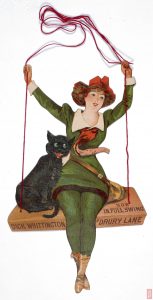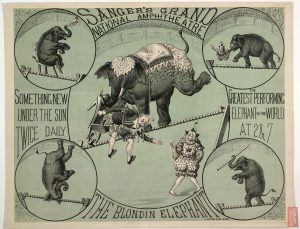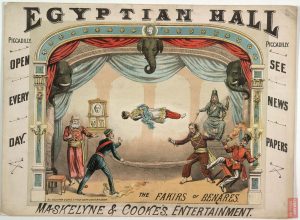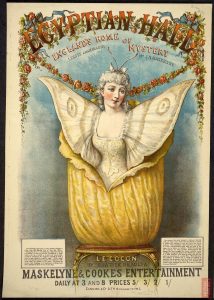Last Thursday, I was lucky enough to be invited to the preview of this small but fascinating exhibition at the British Library. It celebrates late 19th century popular entertainment through vividly-coloured posters, playbills, and various magical artefacts. It concentrates on major entertainment characters, such as Dan Leno, Mr Evanion, ‘Lord’ George Sanger, and John Nevil Maskelyne.
I love this cut-out novelty of Ada Blanche as Dick Whittington on a swing, plus cat in Dan Leno’s pantomime at the Theatre Royal, London in 1894.

Theatre Royal novelty: Now in full swing, Dick Whittington at Drury Lane
As well as Ada Blanche playing Dick, the pantomime also starred Dan Leno (1860-1904) as Idle Jack. Leno was a leading English Music Hall comedian and actor, self-dubbed ‘The Funniest Man on Earth’. He is remembered today as the creator of the original Pantomime Dame. As I wandered round, I could hear the scratchy original sound recordings of his most famous songs, like My Old Man, said Follow the Van, and don’t Dilly-Dally on the Way…

Dan Leno song book
Late Victorian entertainers and impresarios were masters of publicity. They knew the value of a personal sobriquet and they weren’t too bothered if it originated with themselves. For example, the stylishly-dressed conjuror, ventriloquist and humourist, Mr Evanion (1832-1905), was invited to perform for Queen Victoria and her family at Sandringham, and, thereafter, called himself ‘The Royal Conjuror’, giving the impression that he was officially By Royal Appointment, which was not true. ‘Creative’ self-publicity is nothing new.

Mr Evanion. His large collection of ephemera relating to Victorian popular culture was bought by the British Library in 1895 and forms the basis for the exhibition
‘Lord’ George Sanger (1825-1911), was a highly successful circus proprietor. According to the publicity, his show was ‘the Greatest Circus, Hippodrome and Menagerie in the World.’ It was Sanger who brought Buffalo Bill’s show to England. Sanger’s father had been a travelling showman and George began his career as an animal trainer – he advocated kindness. His first troupe (as a child) comprised mice, redpolls and canaries and he taught them to fire miniature cannons and walk tightropes. Later, his most famous trained animal was Toby, the learned pig.

The Great Alvantee, Sanger’s Amphitheatre poster
In 1850 he married the lion tamer, Ellen Chapman (as one does), known professionally as Madame Pauline de Vere. After some setbacks, they formed their own successful circus and in 1871 he bought out Astley’s Amphitheatre – which the Georgette Heyer fans among you will surely recall. He founded his own Amphitheatre in Ramsgate which was a huge success, eventually being rebuilt by the well-known theatre architect, Frank Matcham, and named the Royal Palace Theatre.

The Blondin elephant
I love this poster of Sanger’s ‘Greatest Performing Elephant in the World’ as it walks the tightrope, its trunk curled round a protesting clown. Another cartouche shows the elephant doing a headstand on a tightrope; and sitting on a chair playing the trumpet – also on a tightrope. Oh, to time travel and see these wonders for oneself!

Maskelyne’s ‘Fakirs of Benares’ at the Egyptian Hall
The name Maskelyne is still known today. John Nevil Maskelyne (1839-1917), magician and manager of the famous Egyptian Hall, known as ‘England’s Home of Mystery’, passionately believed in exposing fraudulent séances, which he felt mislead vulnerable people. His shows were highly professional magic acts and illusions, and his ‘apparitions’ are disturbingly real. One of his specialities was the Levitation illusion where his wife rose from the stage as in the picture above from the Fakirs of Benares at the Egyptian Hall. I love the elephant heads decorating the proscenium arch.

‘Le Cocon’ by Buatier de Kolta at the Egyptian Hall
Maskelyne was also an important impresario and he bought in other acts, such as Buatier de Kolta’s dramatic illusion of a lady with wings emerging from a silk cocoon, above.
The exhibition runs from 14th October 14th to 17th December, and the British Library has free Saturday afternoon contemporary performances of Victorian entertainments (3-5pm) during the exhibition’s run; as well as various evening events and a special Christmas Magic Show.
I thoroughly enjoyed the exhibition – and it’s free! I shall definitely get to some of the Saturday afternoon demonstrations of Victorian entertainment; it sounds perfect for anyone with children to keep amused.
All photos courtesy of the British Library, except the Dan Leno songbook, taken by me.
Elizabeth Hawksley
Please share this page...
Fascinating. I can scarcely believe the elephant’s prowess and wonder if it was some kind of trick. Standing on its head on a tightrope? Walking one would be difficult enough! Extraordinary stuff.
It must be an illusion of some sort – they were very clever manipulating lights and mirrors to hide things. I have a book on Victorian magic called ‘Hiding the Elephant’ which explains how the various tricks were done. There’s a famous one called ‘Pepper’s Ghost’ which made a gauzy phantom walk or glide across the stage.
How fascinating. Must see if I can find that book somewhere.
It’s called ‘Hiding the Elephant: How Magicians Invented the Impossible by Jim Steinmeyer, published by Arrow in 2005. It has lots of diagrams, posters and photographs.